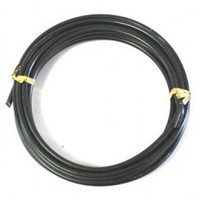Probably the most mysterious thing about bonsai to those outside the art is the fact that the little tree is covered with wire. Perhaps someone might even have thought that the tree with all the wire actually serves as a snazzy television antenna. Those of us inside the art know that the purpose of the wire is to change the shape or direction of a branch to one more in line with our vision of what the tree should look like. Wrapping the branch with wire makes the branch sufficiently stiff that it can be held in a new position. As the tree grows the branch will eventually hold the new position without the aid of the wire.
So what kinds of wire are available to us? There are only three basic types of wire that are readily available, copper, steel, and aluminum. Steel or iron wire is not a good choice for two reasons. First, it generally is so stiff that it would be hard to bend around a branch without breaking the branch. Secondly, it will rust which reduces the strength of the wire over time. Further, the rust products will stain the bark of the tree. This leaves us with a choice of copper or aluminum. Which is best? The simple answer is that they both work well, although each has unique advantages.
Annealed copper is soft, initially making it easy to wrap around a branch. It is also subject to work hardening as it is bent, making it stiffer as the wrapping proceeds. Work hardening copper wire can increase the rigidity of the wire by as much as a factor of two. Surprisingly, aluminum is also subject to work hardening, although the de gree of stiffening is far less than that of copper. As with copper, aluminum can also be annealed, although the softening resulting from the annealing process is far less that that observed for copper.
gree of stiffening is far less than that of copper. As with copper, aluminum can also be annealed, although the softening resulting from the annealing process is far less that that observed for copper.
Copper wire is about three times stiffer than aluminum for a given size of wire in the finally wired branch. Successful wiring of a branch requires that the branch be held securely in the new position for an extended period of time. A rough rule of thumb is that the size of copper wire required to securely hold the branch in the new position should be about one third the size of the branch. Since aluminum is softer than the copper wire, the size of aluminum must be substantially larger than the copper wire to securely hold the branch. Copper is generally preferred for wiring heavy branches because of the greater rigidity. On the other hand, aluminum wire is frequently preferred for wiring small brittle branches on trees such as azaleas or elms. This is because it is soft and less likely to break the branches, and yet is strong enough to hold the branches in place.
Regardless of the type of wire, scarring always lurks in the background. This comes about from the fact that as the tree grows, the branches become thicker. The wire, be it copper or aluminum, does not significantly stretch, so the wire will cut into the bark of the branch as the branch grows in diameter. Wire scars are nearly permanent and disfigure the tree. The beauty of deciduous trees is in the quality of the bark and wire scars are particularly unwelcome. Wire scars are less of a problem with conifers with lots of jins and sharis, but still should be avoided. The wire on trees needs to be checked frequently, and at the first sign of scarring should be removed. The branch must be rewired with fresh wire if the branch does not hold the desired new position. Since aluminum wire is larger in diameter than copper wire of equivalent stiffness, it may scar a little more slowly that the copper, although it should also be watched carefully.

